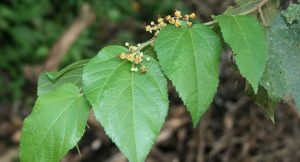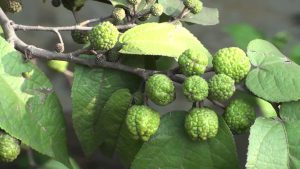
Scientific synonym: Guazuma tomentosa
Family: Sterculiaceae
Other names: West Indian Elm, Cablote, Cualote, Tapaculo, Guacima, Guacimo, Guazuma, Mutamba, Huasimo, Caulote, Guacimillo, Jacocalalu, Gajagua de Toro, Bois d’Orme, Bois de Hetre, Mutamba, Nipaltuntha, Bastard Cedar, Bay Cedar, Goea-azoema.
Habitat: Mexico, Central America and Colombia, Ecuador, Peru, Bolivia, Paraguay, Argentina, and Brazil. It is cultivated in places such as Indonesia and India. Guacima can be found at elevations between sea level and 1200 m. It is common in openings, clearings, pastures, along stream banks, and in secondary forests of disturbed areas [4].
Description

Flowering and Fruit
Flowers in Costa Rica January through March and then in July [8]. The species itself flowers throughout the year, in particular from April to October (Wikipedia).
Constituents
Phytochemical screening of Guazuma ulmifolia fruit and leaf showed the presence of different groups of secondary metabolites viz. alkaloids, tannins, saponins, flavonoids, terpenoids, cardiac glycosides and steroids.
The result from preliminary phytochemical screening revealed that plant extracts shows the presence of alkaloids, steroids, flavonoids, terpenoids, saponins which may exhibit antimicrobial activity. Phenolic compounds have been reported for antioxidative, antidiabetic and antimicrobial activities. Flavonoids are the major group of phenolic compounds reported for their antiviral, antimicrobial properties and antibacterial [2].
Parts Used
Stem bark, leaves and fruits.
Uses
Maya tribe used the leaves as supportive treatment during delivery, to treat digestive disorder, asthma, dysentry, diarrhea, wound and fever. In Jamaica it is used for cuts and sores, sore throat, kidney disorders, constipation, indigestion, dermatitis, coughs and colds [1][4] and dysentery depurative [2]. In India, rustics use Guazuma as an analeptic, antibacterial, anticancer and antidiabetic agent. It also used to treat fever, flu, gonorrhea, sore throat, asthma, diarrhea, and dysentery and to control hair loss [3]. In Guatemala, the plant is used as anti-inflamatory agent, for gastric and stomach ache, and its leaves are used to make tea to relief fever, renal and skin disorders. In Western Ghats the whole plant is used for liquor preparation and nervous disorders. It is also used to treat skin disease, leprosy, syphilis and malaria.
The guacimo has been awarded multiple medicinal uses and is one of the most popular remedies against gastrointestinal diseases. The bark, leaves, flowers and fruits have medicinal use against fever, vomiting, diarrhea, matrix pain, gastritis, diabetes, to treat sores, urine retention, syphilis, cough, malaria, inappetence, antispasmodic, pectoral, catarrh, antipyretic , abdominal pain, antibiotic, anti-diabetic, anti-inflammatory, antiseptic, astringent, hair loss, purgative and to combat epithelial conditions. Roots and ground fruits are emollients and antivenins; The mucilage treated with boiling water is applied for insulation and burns. The bark is used in cooking as a diuretic, in cold water against diarrhea, bloody diarrhea, pus and kidney affections. In Belize, the bark boiled for 10 minutes is drunk for dysentery and diarrhea, aids in prostate problems and is used as a uterine stimulant to speed up labor. (Chizmar 2009 309-310) [5]
Other Uses
The timber is used for posts, general carpentry, interior construction, furniture, barrel stave, boxes, crates, tool handles, gun-stocks and firewood and charcoal. Immature fruit and foliage are browsed by horses and cattle. If eaten to excess, however, fruits may cause intestinal obstruction in cattle. Fruits are also fed to hogs and it can be used as food fresh or cooked. It is a source of honey. Rope and twine can be made from the fibrous bark. The trees are planted as ornamentals and for shade.
Archaeologists today use it to treat murals and stucco (and some Maya already used it to add to lime for making their floors) [5].
Dosage
Dosage recommendation is based on traditional uses of the herb.
Upper respiratory infections, asthma and other respiratory problems: 1 cup of a standard bark decoction 2-3 times daily. [7]
Gastrointestinal problems and other conditions: bark decoction is used or 2-3 ml of a 4:1 tincture twice daily or 1 to 2 grams of powdered bark daily in tablets or capsules or stirred into water or juice. [7]
Hair rinse for hair loss: rinse the hair with bark decoction several times weekly [7].
Infusion, bark: 1 cup 1-3 times daily
Tincture, bark: 2-3 ml twice daily
Capsules, bark: 2 g twice daily
Poultice*, powdered bark, aerial parts: applied externally to affected areas 1 to 3 times daily.
* A poultice is a herbal paste made from the powdered herb or aerial part of the plant. Herb powder is mixed with hot or cold water to form a paste to apply to the area. Also aerial parts such as leaves can be bruised and applied to the affected areas.
Scientific studies
Study of mice : A study was done to assess the gastroprotective effects of an aqueous suspension of the ethanolic extract from leaves and flowers of Guazuma ulmifolia in a model of acute gastric ulcer induced by diclofenac as ulcerogenic agent, using the proton pump inhibitor omeprazole as a protection reference. It was concluded that the aerial parts of Guazuma ulmifolia protect gastric mucosa against the injurious effect of NSAIDs mainly by anti-inflammatory and radical-scavenging mechanisms [6].
Where to buy Cablote
– Rain Forest Pharmacy
– Etsy.com (search for Bastard Cedar or West Indian Elm)
– NutraVal
– Back To your Roots Herbs
– Rain Tree Formulas
– Seed can be bought on Amazon.com, Fit Trade
Note: It is widely known as Mutamba and could also be seen for sale by this name.
Research paper on Guazuma ulmifolia
 Loading...
Loading...
Reference(s)
[1] A Review of Medicinal Plant Research at the University of the West Indies, Jamaica, 1948–2001 SA Mitchell, MH Ahmad
[2] Medicinal Plants of Jamaica. Parts 1 & 11. By G. F. Asprey, M.Sc., Ph.D. (B’ham.), Professor of Botany, U.C.W.l. and Phyllis Thornton, B.Sc. (Liverpool), Botanist Vomiting Sickness Survey. Attached to Botany Department, U.C.W.l.
[3] Pharmacognostic Study of Guazuma Ulmifolia Jayshree U. Patil and S.D. Biradar* Research and Post Graduate Studies, Department of Botany, Dnyanopasak College Parbhani, Maharashtra, India
[4] Guazuma ulmifolia – http://ecocrop.fao.org/ecocrop/srv/en/cropView?id=6562
[5] http://www.maya-ethnobotany.org/images-mayan-ethnobotanicals-medicinal-plants-tropical-agriculture-flower-spice-flavoring/guazuma-ulmifolia-is-absent-from-most-books-on-the-maya-but-it-is-very-common-throughout-guatemala-and-has-dozens-of-uses-including-as-flavor-for-.php (GOOGLE translated from Spanish to English)
[6] The aerial parts of Guazuma ulmifolia Lam. protect against NSAID-induced gastric lesions. https://www.ncbi.nlm.nih.gov/pubmed/17884315
[7] Mutamba – http://www.rain-tree.com/mutamba.htm#.W2byiBhG08o
[8] http://curis.ku.dk/portal-life/files/20647544/guazuma_ulmifolia_int.pdf
DISCLAIMER: THIS WEBSITE DOES NOT PROVIDE MEDICAL ADVICE
The information, including but not limited to, text, graphics, images and other material contained on this website are for informational purposes only. The purpose of this website is to promote broad consumer understanding and knowledge of various health topics. It is not intended to be a substitute for professional medical advice, diagnosis or treatment. Always seek the advice of your physician or other qualified health care provider with any questions you may have regarding a medical condition or treatment and before undertaking a new health care regimen, and never disregard professional medical advice or delay in seeking it because of something you have read on this website.